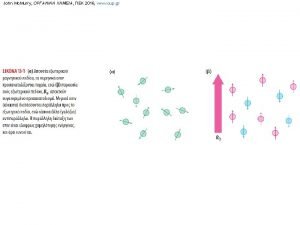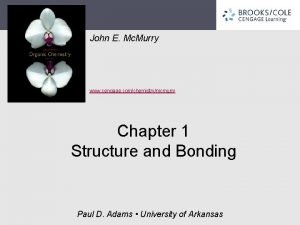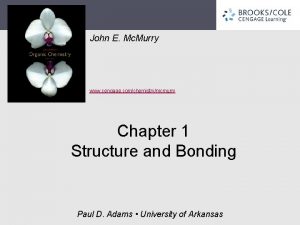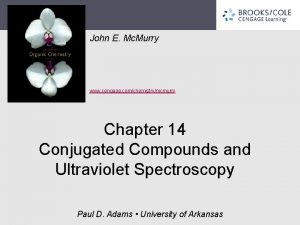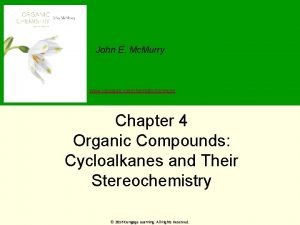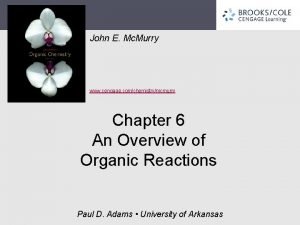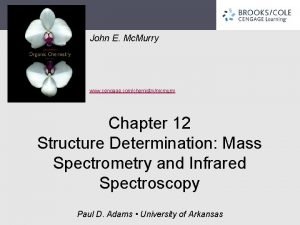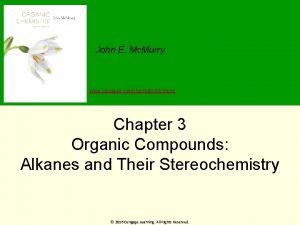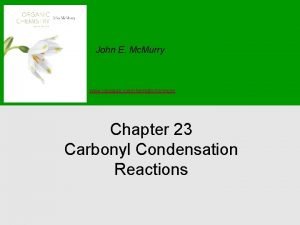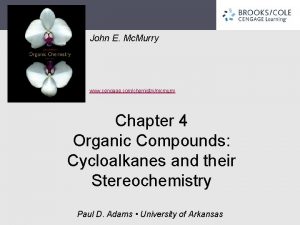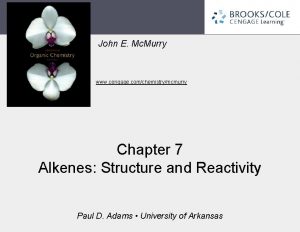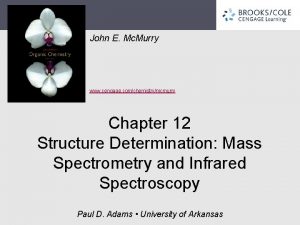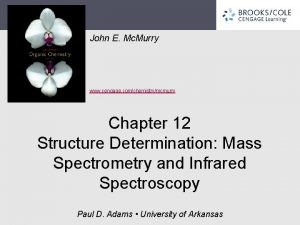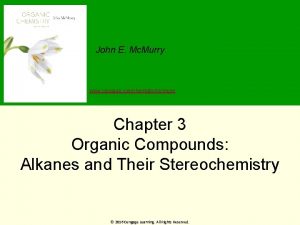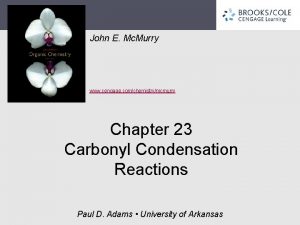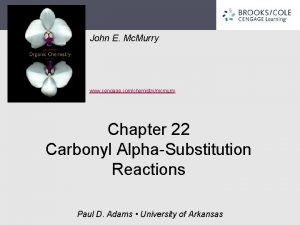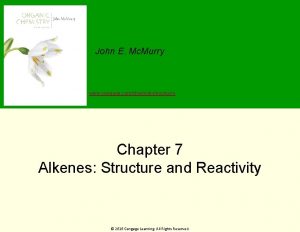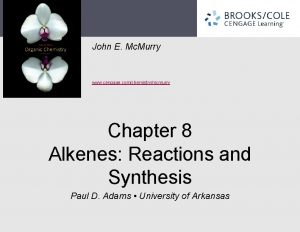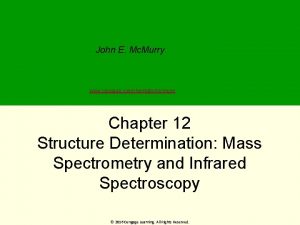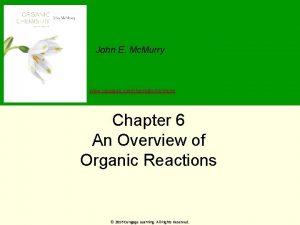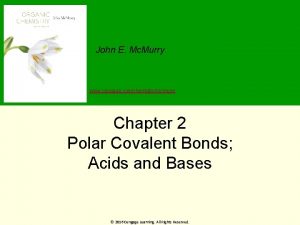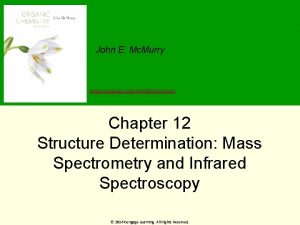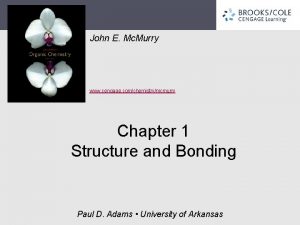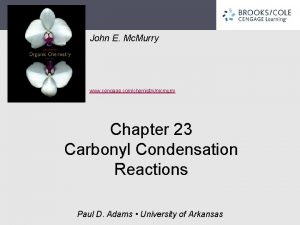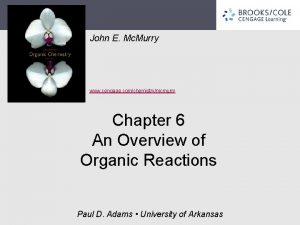John E Mc Murry www cengage comchemistrymcmurry Chapter










































- Slides: 42

John E. Mc. Murry www. cengage. com/chemistry/mcmurry Chapter 16 Chemistry of Benzene: Electrophilic Aromatic Substitution Paul D. Adams • University of Arkansas

Substitution Reactions of Benzene and Its Derivatives § § Benzene is aromatic: a cyclic conjugated compound with 6 electrons Reactions of benzene lead to the retention of the aromatic core

Why this Chapter? § § § Continuation of coverage of aromatic compounds in preceding chapter…focus shift to understanding reactions Examine relationship between aromatic structure and reactivity Relationship critical to understanding of how biological molecules/pharmaceutical agents are synthesized

16. 1 Electrophilic Aromatic Substitution Reactions: Bromination § Benzene’s electrons participate as a Lewis base in reactions with Lewis acids § The product is formed by loss of a proton, which is replaced by bromine § Fe. Br 3 is added as a catalyst to polarize the bromine reagent

Addition Intermediate in Bromination § § The addition of bromine occurs in two steps In the first step the electrons act as a nucleophile toward Br 2 (in a complex with Fe. Br 3) This forms a cationic addition intermediate from benzene and a bromine cation The intermediate is not aromatic and therefore high in energy

Formation of Product from Intermediate § § The cationic addition intermediate transfers a proton to Fe. Br 4 - (from Brand Fe. Br 3) This restores aromaticity (in contrast with addition in alkenes)

16. 2 Other Aromatic Substitutions § § § Chlorine and iodine (but not fluorine, which is too reactive) can produce aromatic substitution with the addition of other reagents to promote the reaction Chlorination requires Fe. Cl 3 Iodine must be oxidized to form a more powerful I+ species (with Cu+ or peroxide)

Aromatic Nitration § § The combination of nitric acid and sulfuric acid produces NO 2+ (nitronium ion) The reaction with benzene produces nitrobenzene

Aromatic Sulfonation § § § Substitution of H by SO 3 H (sulfonation) Reaction with a mixture of sulfuric acid and SO 3 Reactive species is sulfur trioxide or its conjugate acid

Aromatic Hydroxylation § § Direct hydroxylation of an aromatic ring difficult in the laboratory Usually occurs via an enzyme in biological pathways

16. 3 Alkylation of Aromatic Rings: The Friedel–Crafts Reaction § § § Alkylation among most useful electrophilic aromatic subsitution reactions Aromatic substitution of R+ for H+ Aluminum chloride promotes the formation of the carbocation

Limitations of the Friedel-Crafts Alkylation § § § Only alkyl halides can be used (F, Cl, I, Br) Aryl halides and vinylic halides do not react (their carbocations are too hard to form) Will not work with rings containing an amino group substituent or a strongly electron-withdrawing group

Control Problems § Multiple alkylations can occur because the first alkylation is activating

Carbocation Rearrangements During Alkylation § § Similar to those that occur during electrophilic additions to alkenes Can involve H or alkyl shifts

Acylation of Aromatic Rings § Reaction of an acid chloride (RCOCl) and an aromatic ring in the presence of Al. Cl 3 introduces acyl group, COR § Benzene with acetyl chloride yields acetophenone

Mechanism of Friedel-Crafts Acylation § § § Similar to alkylation Reactive electrophile: resonance-stabilized acyl cation An acyl cation does not rearrange

16. 4 Substituent Effects in Substituted Aromatic Rings § § Substituents can cause a compound to be (much) more or (much) less reactive than benzene Substituents affect the orientation of the reaction – the positional relationship is controlled § ortho- and para-directing activators, ortho- and paradirecting deactivators, and meta-directing deactivators (Table 16. 1)

Origins of Substituent Effects § § § An interplay of inductive effects and resonance effects Inductive effect - withdrawal or donation of electrons through a s bond Resonance effect - withdrawal or donation of electrons through a bond due to the overlap of a p orbital on the substituent with a p orbital on the aromatic ring

Inductive Effects § § § Controlled by electronegativity and the polarity of bonds in functional groups Halogens, C=O, CN, and NO 2 withdraw electrons through s bond connected to ring Alkyl groups donate electrons

Resonance Effects – Electron Withdrawal § § C=O, CN, NO 2 substituents withdraw electrons from the aromatic ring by resonance electrons flow from the rings to the substituents

Resonance Effects – Electron Donation § § § Halogen, OH, alkoxyl (OR), and amino substituents donate electrons flow from the substituents to the ring Effect is greatest at ortho and para

16. 5 An Explanation of Substituent Effects § § Activating groups donate electrons to the ring, stabilizing the Wheland intermediate (carbocation) Deactivating groups withdraw electrons from the ring, destabilizing the Wheland intermediate

Ortho- and Para-Directing Activators: Alkyl Groups § § Alkyl groups activate: direct further substitution to positions ortho and para to themselves Alkyl group is most effective in the ortho and para positions

Ortho- and Para-Directing Activators: OH and NH 2 § § Alkoxyl, and amino groups have a strong, electron-donating resonance effect Most pronounced at the ortho and para positions

Ortho- and Para-Directing Deactivators: Halogens § § Electron-withdrawing inductive effect outweighs weaker electrondonating resonance effect Resonance effect is only at the ortho and para positions, stabilizing carbocation intermediate

Meta-Directing Deactivators § § § Inductive and resonance effects reinforce each other Ortho and para intermediates destabilized by deactivation of carbocation intermediate Resonance cannot produce stabilization

Summary Table: Effect of Substituents in Aromatic Substitution

16. 6 Trisubstituted Benzenes: Additivity of Effects § If the directing effects of the two groups are the same, the result is additive

Substituents with Opposite Effects § § If the directing effects of two groups oppose each other, the more powerful activating group decides the principal outcome Usually gives mixtures of products

Meta-Disubstituted Compounds § § The reaction site is too hindered To make aromatic rings with three adjacent substituents, it is best to start with an ortho-disubstituted compound

16. 7 Nucleophilic Aromatic Substitution § § § Aryl halides with electron-withdrawing substituents ortho and para react with nucleophiles Form addition intermediate (Meisenheimer complex) that is stabilized by electronwithdrawal Halide ion is lost to give aromatic ring

16. 8 Benzyne § § § Phenol is prepared on an industrial scale by treatment of chlorobenzene with dilute aqueous Na. OH at 340°C under high pressure The reaction involves an elimination reaction that gives a triple bond The intermediate is called benzyne

Evidence for Benzyne as an Intermediate § § Bromobenzene with 14 C only at C 1 gives substitution product with label scrambled between C 1 and C 2 Reaction proceeds through a symmetrical intermediate in which C 1 and C 2 are equivalent— must be benzyne

Structure of Benzyne § § § Benzyne is a highly distorted alkyne The triple bond uses sp 2 -hybridized carbons, not the usual sp The triple bond has one bond formed by p–p overlap and another by weak sp 2–sp 2 overlap

16. 9 Oxidation of Aromatic Compounds § § Alkyl side chains can be oxidized to CO 2 H by strong reagents such as KMn. O 4 and Na 2 Cr 2 O 7 if they have a C– H next to the ring Converts an alkylbenzene into a benzoic acid, Ar R Ar CO 2 H

Bromination of Alkylbenzene Side Chains § Reaction of an alkylbenzene with N-bromosuccinimide (NBS) and benzoyl peroxide (radical initiator) introduces Br into the side chain

Mechanism of NBS (Radical) Reaction § § Abstraction of a benzylic hydrogen atom generates an intermediate benzylic radical Reacts with Br 2 to yield product Br· radical cycles back into reaction to carry chain Br 2 produced from reaction of HBr with NBS

16. 10 Reduction of Aromatic Compounds § § § Aromatic rings are inert to catalytic hydrogenation under conditions that reduce alkene double bonds Can selectively reduce an alkene double bond in the presence of an aromatic ring Reduction of an aromatic ring requires more powerful reducing conditions (high pressure or rhodium catalysts)

Reduction of Aryl Alkyl Ketones § § Aromatic ring activates neighboring carbonyl group toward reduction Ketone is converted into an alkylbenzene by catalytic hydrogenation over Pd catalyst

16. 11 Synthesis of Polysubstituted Benzenes § § These syntheses require planning and consideration of alternative routes Ability to plan a sequence of reactions in right order is valuable to synthesis of substituted aromatic rings

Let’s Work a Problem Using resonance structure of the intermediates, explain why bromination of biphenyl occurs at ortho and para positions, rather than at meta?

Answer The positively charged intermediates that can be formed from ortho or para attack are stabilized by resonance contributions from the neighboring in the biphenyl which is NOT possible in meta attack.
 Mc murry
Mc murry Chapter 7:10 respiratory system
Chapter 7:10 respiratory system Cengage chapter 7
Cengage chapter 7 Chapter 13 medical math assignment sheet
Chapter 13 medical math assignment sheet Chapter 13 study guide accounting
Chapter 13 study guide accounting Cengage chapter 7
Cengage chapter 7 Cengage learning heart diagram
Cengage learning heart diagram Chapter 8 the digestive system
Chapter 8 the digestive system Alges root word
Alges root word Chapter 4 the muscular system
Chapter 4 the muscular system Prescription terms
Prescription terms Cengage differential equations
Cengage differential equations Bank reconciliation cengage
Bank reconciliation cengage Separation of variables differential equations
Separation of variables differential equations Chapter 6:2 interpreting word parts
Chapter 6:2 interpreting word parts Cengage learning heart diagram
Cengage learning heart diagram Cengage
Cengage Cengage
Cengage Cengage
Cengage South-western cengage learning
South-western cengage learning Cengage
Cengage Cengage
Cengage Cengage
Cengage 2009 delmar cengage learning
2009 delmar cengage learning Cengage learning heart diagram
Cengage learning heart diagram Chapter 1 learning exercises medical terminology
Chapter 1 learning exercises medical terminology Cengage learning australia
Cengage learning australia 2009 delmar cengage learning
2009 delmar cengage learning Cengage learning
Cengage learning Cengage learning
Cengage learning Module 5 computer concepts exam answers
Module 5 computer concepts exam answers Cengage
Cengage Wadsworth cengage learning
Wadsworth cengage learning Cengage
Cengage Cengage learning
Cengage learning Cengage
Cengage Cengage learning plant cell
Cengage learning plant cell Cengage
Cengage Cengage learning
Cengage learning Motivation, ability, and opportunity consumer behaviour
Motivation, ability, and opportunity consumer behaviour Cengage learning
Cengage learning Consumer diversity in consumer behaviour
Consumer diversity in consumer behaviour Dissociative
Dissociative
